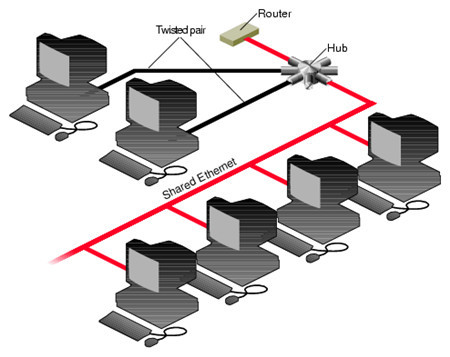Ethernet is the most widely used LAN technology up to now, connecting more than 85 percent of the world’s LAN-connected PCs and workstations. Ethernet refers to the family of computer networking technologies covered by the IEEE 802.3 standard, and can run over both optical fiber and twisted-pair cables. Over the past years, Ethernet has steadily evolved to provide additional performance and network intelligence. This continual improvement has made Ethernet an excellent solution for industrial applications. Understanding how Ethernet developed can provide a foundation that will improve your understanding of networking in general. Figure 1 shows how systems might be connected to an Ethernet network.

Ethernet—A Brief History
The original Ethernet was developed as an experimental coaxial cable network in the 1970s by Xerox Corporation to operate with a data rate of 3 Mbps using a carrier sense multiple access collision detect protocol for LANs (CSMA/CD )with sporadic but occasionally heavy traffic requirements. Success with that project attracted early attention and led to the 1980 joint development of the 10 Mbps Ethernet. Since then, a number of supplements to the standard have been defined to take advantage of improvements in the technologies and to support additional network media and higher data rate capabilities, plus several new optional network access control features. Throughout the rest of this chapter, the terms Ethernet and 802.3 will refer exclusively to network implementations compatible with the IEEE 802.3 standard.
The original Ethernet was developed as an experimental coaxial cable network in the 1970s by Xerox Corporation to operate with a data rate of 3 Mbps using a carrier sense multiple access collision detect protocol for LANs (CSMA/CD )with sporadic but occasionally heavy traffic requirements. Success with that project attracted early attention and led to the 1980 joint development of the 10 Mbps Ethernet. Since then, a number of supplements to the standard have been defined to take advantage of improvements in the technologies and to support additional network media and higher data rate capabilities, plus several new optional network access control features. Throughout the rest of this chapter, the terms Ethernet and 802.3 will refer exclusively to network implementations compatible with the IEEE 802.3 standard.
- 10BASE-T
This most commonly installed Ethernet delivers performance of up to 10 Mbps over twisted-pair copper cable.
- 100BASE-T
A single LAN specification, also known as Fast Ethernet, that delivers a speed increase of 10 times the 10BASE-T Ethernet specification (100 Mbps) while retaining many of Ethernet’s technical specifications. These similarities enable organizations to use 10BASE-T applications and network management tools on Fast Ethernet networks.
- Gigabit Ethernet or 1000-Mbps Ethernet
Gigabit Ethernet extends the Ethernet protocol even further, increasing speed tenfold over Fast Ethernet to 1000 Mbps, or 1 Gbps. Because it is based upon the current Ethernet standard and compatible with the installed base of Ethernet and Fast Ethernet switches and routers, network managers can support Gigabit Ethernet without needing to retrain or learn a new technology.
- 10 Gigabit Ethernet
10 Gigabit Ethernet is an upcoming Ethernet technology that ratified as a standard in June 2002, which is an even faster version of Ethernet. Its high data rate of 10 Gbps makes it a good solution to deliver high bandwidth in WANs and metropolitan-area networks (MANs). 10 Gigabit Ethernet uses multimode optical fiber up to 300 meters and single mode fiber up to 40 kilometers.
- 40/100 Gigabit Ethernet
40 Gigabit Ethernet and 100 Gigabit Ethernet are developed by the IEEE 802.3ba Task Force to support sending Ethernet frames at 40 and 100 gigabits per second. They also address physical layer specifications for communication across backplanes, copper cabling, multimode-fiber, and single-mode fiber. The most commonly installed Ethernet systems lately are 40/100 Gigabit Ethernet. They are the rising star in telecom field. 40 Gigabit Ethernet transceivers and cables are being developed along several standard in order to support this new technology. For example, QSFP-4X10G-AOC10M, compared with Cisco DAC cables (like QSFP-H40G-CU5M for a distance of 5m), can support a longer link length.
Summary
Compared to traditional, non-Ethernet-based industrial solutions that have a data rate of between 500 Kbps to 12 Mbps, Ethernet technology can deliver substantially higher performance. And, because it is based on industry standards, it can run and be connected over any Ethernet-compliant device from any vendor. Limited by my own knowledge, there are many aspects of Ethernet that I haven’t talked about. If you are interested in this topic, please leave your comment to share with us.
Compared to traditional, non-Ethernet-based industrial solutions that have a data rate of between 500 Kbps to 12 Mbps, Ethernet technology can deliver substantially higher performance. And, because it is based on industry standards, it can run and be connected over any Ethernet-compliant device from any vendor. Limited by my own knowledge, there are many aspects of Ethernet that I haven’t talked about. If you are interested in this topic, please leave your comment to share with us.
评论
发表评论